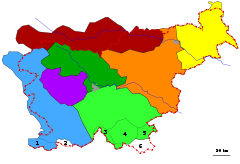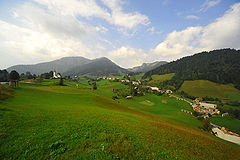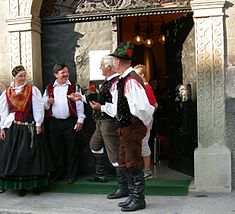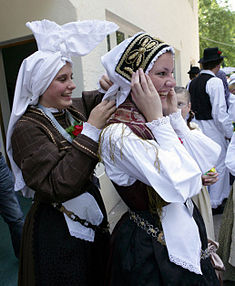- Upper Carniola
-
Upper Carniola (Slovene: Gorenjska; German: Oberkrain) is a traditional region of Slovenia, the northern mountainous part of the larger Carniola region. The centre of the region is Kranj,[1] while other urban centers include Jesenice, Tržič, Škofja Loka, Kamnik, and Domžale.
Contents
Historical background
Its origins can be traced back to the 17th century, when the Habsburg duchy of Carniola was divided into three administrative districts, given by the scholar Johann Weikhard von Valvasor in his 1689 work The Glory of the Duchy of Carniola. The districts were known in German as Kreise (kresija in Slovene): Upper Carniola with its centre in Ljubljana, comprising the north of the duchy, Lower Carniola, comprising the east and south-east, with its centre in Novo Mesto, and Inner Carniola comprising the west and south-west of the duchy, with its centre in Postojna.
This division remained, in different arrangements, up to the 1860s, when the old administrative districts were abolished and Upper Carniola was subdivided into the smaller Austrian Bezirke of Kranj, Radovljica and Kamnik. Nevertheless, the regional identity remained strong also thereafter. Upon the dissolution of Austria-Hungary after World War I, when Carniola ceased to exist as a separate political and geographical unit being incorporated into the Kingdom of Serbs, Croats and Slovenes, the Carniolan regional identity soon faded away, but the regional identification with its sub-units (Upper, Lower and, to a lesser extent, Inner Carniola) remained strong.
Geographical extension
Upper Carniola is bounded by Carinthia (i.e. the Austrian state of Carinthia and Slovenian Carinthia) in the north, the historic Lower Styria (Štajerska) region in the east and the Slovenian Littoral (Primorska) in the west. In the south, the Ljubljanica and Sava rivers form the border to Inner Carniola and Lower Carniola resp. The landscape is characterised by the mountains of the Southern Limestone Alps, predominantly by the Julian Alps and the Karavanke range at its northern rim.
Historically, Ljubljana was part of Upper Carniola. However, already in the 19th century, it started to be considered as a separate unit; already by the late 18th century, there are very few reference to the people of Ljubljana as "Upper Carniolans" (Gorenjci, Oberkrainer): it was a general perception that Upper Carniola proper starts only north of Ljubljana. Since the 19th century, Kranj, not Ljubljana, is considered as the unofficial capital of Upper Carniola.
Nowadays, the borders of Upper Carniola are usually identified with those of the Slovene statistical region of Gorenjska, though the areas are only roughly congruent. E.g. the municipality of Jezersko used to be part of the Duchy of Carinthia, in 1918 it was occupied by Slovene volunteers and annexed to Yugoslavia by the 1919 Treaty of Saint-Germain. Nevertheless it is today generally considered as an integral part of Upper Carniola, rather than of Slovenian Carinthia.
Culture and traditions
 Map of groups of Slovene dialects, with the Upper Carniolan dialect group in dark green. The Rovte dialect group, in purple, extends in the eastern areas of the regions, while dialects from the Carinthian dialect group, in brown, are spoken in the region's north-westernmost edge.
Map of groups of Slovene dialects, with the Upper Carniolan dialect group in dark green. The Rovte dialect group, in purple, extends in the eastern areas of the regions, while dialects from the Carinthian dialect group, in brown, are spoken in the region's north-westernmost edge.
Language
Traditionally, most of the people of Upper Carniola spoke the Upper Carniolan dialect (gorenjsko narečje), which is one of the geographically most extended and linguistically most compact Slovene dialects. It covers most of the province, except for some peripheric areas in south-western and north-western Upper Carniola, and it also extends to the northern suburbs of Ljubljana. It belongs to the Upper Carniolan dialectal group, one of the seven dialect groups in which the Slovene language is divided. The group also includes the Selško dialect, spoken in the mountainous Upper Carniolan villages of Železniki, Selca, Dražgoše and Davča.
These two Upper Carniolan dialects are spoken in the vast majority of Upper Carniola: this convergence of linguistic and geographical borers is quite exceptional in Slovenia, and it reinforces the cohesiveness of Upper Carniolan regional identity.
Nevertheless, other dialects are spoken in Upper Carniola, as well: in the village of Rateče, people speak a Carinthian Slovene dialect, and in the area around Kranjska Gora and Gozd Martuljek, a transitional dialect between the Carinthian and Upper Carniolan dialect group is spoken. In the mountainous areas of eastern Upper Carniola (mostly in the municipalities of Škofja Loka and Gorenja vas-Poljane), dialects from the Rovte dialect group are spoken.
Beginning in the 18th century, the Upper Carniolan dialect became the basis on which standard Slovene was developed. During the late Enlightenment and early Romantic period, many of the most important Slovene authors and philologists came from the region: Marko Pohlin, Jurij Japelj, Anton Tomaž Linhart, Jernej Kopitar, Matija Čop, and Janez Bleiweis. The poet and journalist Valentin Vodnik, who was born in Šiška, now a suburb of Ljubljana, also wrote in the Upper Carniolan dialect. The first two Slovene language newspapers, Lublanske novice (1797–1800) and Kmetijske in rokodelske novice were also published in the Upper Carniolan regional variety of Slovene. The poetic language of France Prešeren, the Slovenian national poet, also has many specific Upper Carniolan features. Most of the Slovene literary production from that period (1780–1840) thus had recognizable Upper Carniolan linguistic features. In the 1840s and 1850s, many of these features were removed from the literary standard; nevertheless, a basic agreement was reached among Slovene philologist, according to which the vowel system in the standard language was taken from the Upper Carniolan dialect, and the consonant system from Lower Carniolan.
Despite several special distinctive features, the Slovene spoken in Upper Carniola is closer to the standard language than anywhere else in Slovenia.
Folklore and music
In many ways, the folklore of Upper Carniola is considered the prototype of Slovene national folklore. The Upper Carniolan folk costume is frequently used as the representation of the Slovene national costume.[2] In the mid 19th century, during the Slovene national revival, the Slovene nationals took the national costume from Bled and transformed it in the Slovenian national costume.[3] Upper Carniola is also important for Slovene folklore because of the music. In the 1950s, the folk musician Slavko Avsenik popularized a modernized version of the Upper Carniolan folk music.
Images
-
Plague pillar in Škofja Loka
-
St. Mark's parish church in Vrba
-
Planica Valley
-
View of Kranj
-
The Julian Alps
References
- ^ "About Kranj: Walking through the city". Zavod za turizem Kranj. 7 August 2009. http://www.tourism-kranj.si/ZTK_EN,,o_kranju,o_mestu,sprehod_po_mestu.htm. Retrieved 7 August 2009.
- ^ http://www.welcome-to-slovenia.com/content?ContentID=129
- ^ http://www.welcome-to-slovenia.com/content?ContentID=129
External links
- Kje so naše meje?. About the borders of Upper Carniola. (Slovene)
Categories:
Wikimedia Foundation. 2010.















